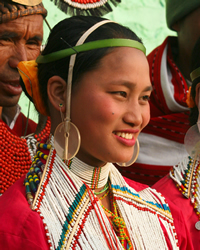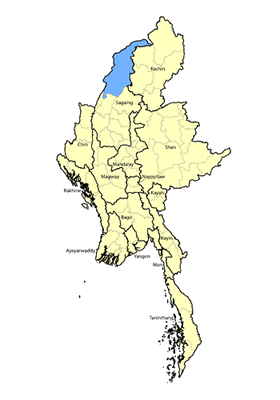Tribally and culturally, the Akyaung Ari are considered part of the larger Tangkhul Naga group, but their language has branched off over the centuries and is now very distinct from Tangkhul. While acknowledging a broad historical association with the large ethnicity, consisting of about 200 tribes that spread far into northeast India, the Akyaung Ari are proud of their distinctive culture and identity within the larger cluster.
Location: A small yet significant tribe, the 1,200 Akyaung Ari Naga inhabit the three villages of Heinkut, Jagram, and Ngachan within the Leshi Township in the Naga Self-Administered Zone of western Myanmar's Sagaing Region. The special zone was established in 2008 after a change in the nation's constitution. The area is remote and rugged, and although the Akyaung Ari homeland is only about 25 miles in a straight line from the Indian state of Nagaland, impenetrable jungles make the journey almost impossible to make. On the Myanmar side, the area may soon open to the outside world, with a major road being constructed from Leshi down to the Chindwin River at the town of Tamanthi. If it is completed, Leshi will suddenly become accessible to new people, ideas, and trading opportunities.
Language: The Akyaung Ari Naga speak their own distinct language, which is significantly different from other Naga varieties in the area. Many use Tangkhul Naga as a second language, even though the two languages share only a 52% lexical similarity. Akyaung Ari Naga enjoys widespread use among the members of the tribe and is not in danger of dying out.
Headhunting was rife among the Naga people in this remote part of Myanmar, with raids causing the population to remain low and live in constant fear of being attacked. Many villages were constructed at the top of mountain ridges for security, as the elevated position enabled them to see any approaching enemies. Although headhunting was officially outlawed in 1969, tribal hostility continues to simmer below the surface, with occasional outbreaks of violence despite most Naga people in the area now being more peaceable since they adopted the Christian faith.
Despite their poverty, Akyaung Ari Naga women take pride in their appearance and love to wear their best traditional red dresses with dozens of necklaces during festivals and special occasions. Because of its isolation and poverty, in 2020 the entire Naga Self-Administered Zone had only two doctors to serve its 130,000 residents. In August 2016, an outbreak of measles killed 44 children as the disease wreaked havoc among the unvaccinated population.
Although almost all Akyaung Ari Naga people claim to be Christians, in Myanmar a family must declare a child's religion at birth, which often leads to such designations being nominal religious labels rather than representations of a living faith. The Akyaung Ari Naga became Christians in the 1960s and 1970s, as many Naga tribes converted throughout the region. Traditionally, many tribes worshipped the sun and moon, which is now formally called the Donyi Polo (“sun-moon”) religion. The elaborate headdresses of some groups are designed to show their adoration of the sun.
Although all three villages contain at least one church, the influence of animism persists among the Akyaung Ari Naga. Almost all members of this tribe profess to be Christians, but because theirs is not a written language, no portions of the Bible exist in their heart language, which has adversely affected the growth of Christianity among them. The Tangkhul Naga Bible was first printed in 1989, but most Akyaung Ari Naga people are unable to understand it. The only Christian resource known to exist in Akyaung Ari Naga are audio recordings produced by the ministry Global Recordings.
Scripture Prayers for the Naga, Akyaung Ari in Myanmar (Burma).
| Profile Source: Asia Harvest Copyrighted © Used with permission |











